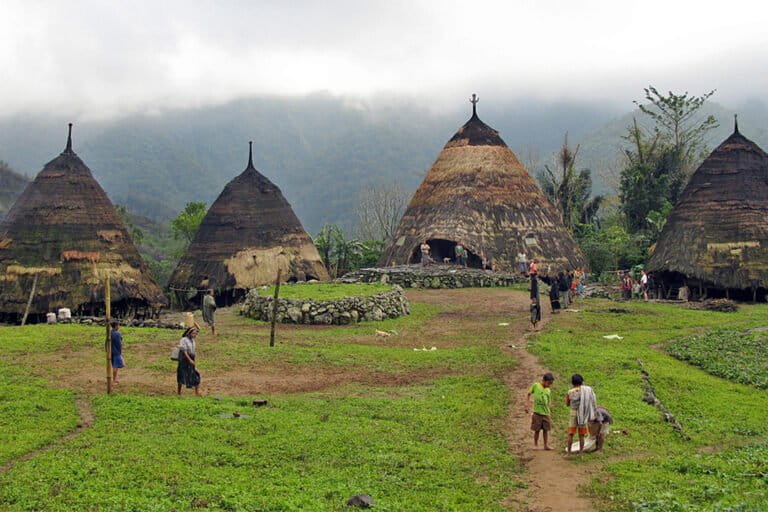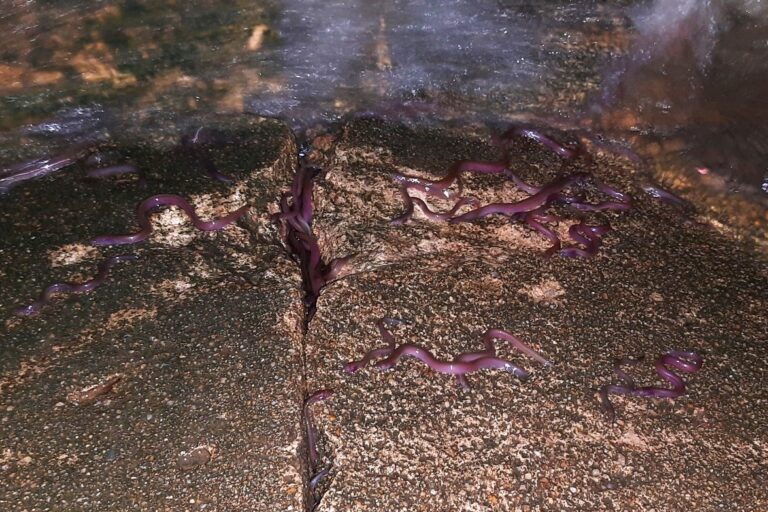- The Japanese government aims to convert at least 25% of all its farmland to organic by 2050, a significant jump from just 0.5% in 2020.
- Researchers found that urban and semi-urban farmers in Tokyo tend to adopt environmentally friendly practices more often than rural farmers, in response to a more environmentally conscious populace, a greater number of organic food stores and restaurants, and freedom from pressure to conform with farming practices in rural communities.
- Japan’s urban farmers are also more likely to diversify their business, such as by engaging in direct sales and creating hands-on farming events or volunteer opportunities, strengthening their ties with the local community.
- Despite positive steps, agricultural land in Tokyo continues to shrink, mirroring a trend in declining biodiversity. Advocates say continued efforts will be needed to preserve and make the best use of the capital’s urban farms.
TOKYO — The train to the farm rose from Tokyo’s labyrinthine subway network, revealing a hodgepodge of gray and tan buildings stretched on either side. The world’s largest metropolitan area, better known for crushing rush hours and gleaming lights, seemed an unlikely place for anyone to be growing organic vegetables.
But only a few minutes’ walk from the station, past apartment buildings and convenience stores, the Hasune Farm was buzzing with life (especially its beehives). The owners and volunteers moved between a produce stand-slash-workspace and rows of late-winter produce. When the people weren’t looking, brown-eared bulbuls (Hypsipetes amaurotis) darted into the field to find a morsel. Behind the workspace stood rainwater tanks and a nursery for seedlings. Between the rows of vegetables, grasses and groundcovers grew alongside their edible counterparts.
The Hasune Farm is one glimpse of a possible future for urban agriculture in Japan. The Japanese government aims to convert at least 25% of all farmland to organic by 2050, a significant jump from just 0.5% in 2020. (Globally, 1.6% of farmland was organic as of 2021.)
The pockets of agriculture in Tokyo are key examples of how Japan could achieve its goal. In recent years, Tokyo farmers, community members and administrators have been working to make such farmland a valuable part of the urban environment through promoting agroecology, such as low-carbon, circular food economies and biodiversity.
That said, Tokyo’s farmland has been steadily shrinking due to low profitability and a history of strict taxes. In 2021, farmland comprised 2.9% of the Tokyo metropolitan area — including both the highly urbanized eastern side and the more suburban and rural western side — a 15% reduction from 2011.
Globally, the U.N. has predicted that 68% of the world’s population will live in urban areas by 2050, compared with 55% in 2018. Increasing urbanization is especially pronounced in Japan, even as the country’s total population has begun to fall. Experts note that in a society with a decreasing population such as Japan, urban farming will become increasingly important as society reorganizes.


Conscientious customers
Like in many places around the world, farming in Japan has been transformed over the past century. After World War II, the government promoted field consolidation and widespread use of chemicals to boost output and productivity. However, these measures also negatively impacted biodiversity.
The minority of farmers who bucked this trend included, perhaps most famously, the late Masanobu Fukuoka, who pioneered a no-till, zero-waste, “natural farming” method that aims to maintain the land’s productivity without chemicals. Fukuoka can be seen as having taken an agroecological approach to farming, which aims to achieve sustainable food systems that give consumers choice over what they eat and how it’s produced while maintaining natural resources and biodiversity. In his writings, Fukuoka claimed that modern agricultural techniques such as applying fertilizers and insecticides became necessary due to how badly humans had upset the land’s “natural balance.”
Today, the ecological benefits of organic and natural farming are more widely recognized in Japan, if not widely practiced.
But Japan’s urban farmers are in a unique position to help lead this transition. In 2020, the agriculture ministry’s research institute found that urban and semi-urban farmers in Tokyo and Osaka tend to adopt environmentally friendly practices more often than rural farmers.
“An urban population is more concerned with environmental protection or food safety,” and urban farmers may make their practices more environmentally sustainable to meet this demand, the author wrote.
This was the case for organic farmers Kazutoshi and Miho Sekita, whose Soramame Farm grows crops such as kiwi, lettuce, tomato, eggplant, sweet potato, and edamame beans on 500 square meters (5,400 square feet) of family-owned land in Tokyo’s Setagaya ward.

The Sekitas told Mongabay that they originally fertilized their soil with animal manure, with mixed results. After a customer’s inquiry, they switched to a homemade fermented mixture of rice bran and other organic waste like fallen leaves.
“The customer asked us what the animals producing the fertilizer had eaten, but we … didn’t know,” Kazutoshi said. Although the Sekitas had committed themselves to organic farming and food safety after the birth of their first child in 2010, the customer’s input gave them a new perspective.
Before settling on the rice bran mixture, the Sekitas experimented with adding dried crab and fish to their fertilizer. “But then we thought, ‘There aren’t any fish [in the environment] here,’ so we stopped,” Kazutoshi said. Miho chimed in, “No crabs either.”
The idea, they explained, was to remove as many unnatural elements from their farm as possible.
They approached weeds and bugs similarly. Rather than remove grasses and other groundcovers from the plot, the Sekitas trim them when they grow too tall, leaving behind their roots. They also lay produce waste between the field’s rows, which often contain more than one variety of vegetable. Under the farmers’ feet, the nutrients gradually return to the soil.
The Sekitas say they feel their farm’s little ecosystem has achieved a kind of natural balance.
“Maybe, because of this, we don’t get big increases in harmful insects,” Kazutoshi said, adding,
“I think it’s safe to say the people who come [to buy our produce] agree with the way we grow vegetables and our approach.”
The Soramame Farm is registered with the Tokyo Metropolitan Government’s eco-agricultural product certification system, an initiative that aims to promote food safety and lessen farming’s environmental impact. Registered farmers get access to a certification logo.
The initiative also provides farmers with information on how to maintain nutrient-rich soil without chemical fertilizers, according to Shinichi Takahashi, senior director for food safety at the Tokyo Metropolitan Government, and how to wean crops off pesticides while still protecting them from insects and disease.


Cities a haven for ecologically minded farmers — and bees
In 2023, a report by Tokyo-based researchers found that a higher proportion of farmers in urban areas also choose to diversify their businesses to include initiatives that address social challenges.
In cities, “small-scale farmers engage in activities such as selling their produce directly to locals, providing it for school lunches, or offering hands-on farming workshops,” Hironori Yagi, a University of Tokyo professor and co-author of the report, told Mongabay.
Urban areas, Yagi said, tend to have a greater number of restaurants and organic food stores, providing an easily accessible market. Additionally, urban farms often cultivate small quantities of various kinds of produce throughout the year, making it easier to sustain direct sales to locals.
Organic farming may actually be easier in cities, Yagi said, as rural farmers who rely on agricultural chemicals sometimes don’t take kindly to their neighbor going organic, out of fear that their own crops will be affected by pests or disease.
The Hasune Farm, whose lively field contrasts sharply with its highly urbanized surroundings in Tokyo’s Itabashi ward, is another example of an organic, diversified farm. Owned by Mayumi Kawaguchi and Yu Tominaga, the farm is run with the help of volunteers, including university students. The farm also manages a nearby restaurant that serves dishes using its produce. Next to the restaurant, they compost organic waste that would otherwise be burned in incinerators.
“Our methods are somewhere between organic and natural farming,” Tominaga told Mongabay, noting that it might not be feasible to totally replicate Fukuoka’s natural farming style in an urban area. “We’re still trying to find the method that works best for us.”
The Hasune Farm keeps its bees for honey production. Across Japan, honey bee populations have fallen due to widespread usage of pesticides.
“In Japan, the vast majority of farmers still use agricultural chemicals, especially on large farms in the countryside,” Kawaguchi said. “Ironically, honey bees may find it easier to live in cities, as home gardens and parks don’t usually use pesticides.”


Wet rice fields, traditional oases for biodiversity in Japan, in short supply in cities
Until recent years, understanding of the environmental benefits of urban farming had been relatively low in Japan, according to Yagi.
In 2019, he participated in an international Urban Agriculture World Summit hosted by Tokyo’s Nerima ward, in which activists and urban farmers from Jakarta, London, New York, Seoul and Toronto stressed the importance of urban farming and local consumption as a climate change countermeasure.
“It made the Japanese farmers present realize that they could express the importance [of urban farming] with this kind of framework as well,” Yagi said.
Tokyo’s urban farms are also valued as temporary evacuation sites in case of a disaster such as a major earthquake or fire, said Keisuke Shibuya, manager for agricultural promotion at the Tokyo Metropolitan Government, who spoke to Mongabay alongside Takahashi.
Policymakers are paying more attention to urban agriculture’s role in supporting biodiversity as well.
Tokyo’s Red Data Book on endangered species notes that habitat loss and the decline of traditional lands threaten urban biodiversity; it lists 209 species already extirpated from Tokyo, mainly plants and insects. Tokyo aims to “halt and reverse biodiversity loss” by 2030 and to improve the quality of urban farmland, according to its Biodiversity Strategy.
One important form of agriculture with rich biodiversity has largely vanished from Tokyo, however: rice fields.
Shibuya attributed this to economics. “Rice farming can be profitable if you have a large area to farm, but on Tokyo’s small patches of agricultural land it’s more lucrative to raise vegetables or fruits.”
On the other hand, Shibuya echoed Yagi in saying that Tokyo’s agriculture is defined by “high-mix, low-volume” cultivation. “It raises land use efficiency,” he said. And, as farms like Soramame show, such spaces can still support stable, if small, ecosystems.

Support from community, policymakers essential for urban farms’ survival
In Tominaga’s view, the biggest strength of urban farming is being near so many people.
Community members can become important allies for urban farmers. Starting in 2023, the Hasune Farm implemented a community-supported agriculture program, or CSA, where members receive a box of veggies every month. They’re also invited to farm events and can drop off their organic waste at the farm.
Tominaga said he expected CSA members to hail from Tokyo’s wealthier areas, but he was pleasantly surprised to find that the majority were from the Hasune Farm’s own ward.
“We emphasize local production and local consumption,” he said, and starting the CSA program “made me realize that there are still many members of our community who value it too.”
Of course, farmers aren’t guaranteed friendly neighbors in the city. “We have to be really careful not to attract complaints,” Tominaga noted. The Hasune Farm’s bees have, he said, occasionally been a source of neighborly nerves.
Beyond gaining the trust of their community, succession is another issue that threatens the long-term sustainability of Tokyo’s urban farms, most of which are family-owned.
According to Yagi’s research, only 30% of urban farms had secured successors as of 2020. Farmland in Setagaya ward, where the Soramame Farm is located, shrank by more than half — from 3.3% to 1.5% of total area — from 1996 to 2022. In Itabashi ward, where the Hasune Farm is located, farmland represents just 0.5% of the ward’s total area as of 2022.

Historically, high property taxes made it difficult for urban farmers to earn a living, and high succession taxes discouraged younger generations from taking over the family farm, according to Yagi. New legislation passed in 2015 and 2018 aimed to lessen the tax burden on urban farmers and secure farm renters, but Tokyo has yet to see a major turnaround on lost farmland.
If sufficient renters or successors can’t be found, converting farmland to parks is another way to preserve the land’s environmental functions.
Still, Yagi said he retains faith in the ingenuity of Tokyo’s urban farmers: “Little by little, they are creating new paths forward.”
Banner image: A bee with a sunflower in Tokyo. Image by mrhayata via Flickr (CC BY-SA 2.0).
Organic farming, and community spirit, buoy a typhoon-battered Philippine town
Japanese butterfly conservation takes flight when integrated with human communities
Citations:
Katayama, N., Baba, Y. G., Kusumoto, Y., & Tanaka, K. (2015). A review of post-war changes in rice farming and biodiversity in Japan. Agricultural Systems, 132, 73-84. doi:10.1016/j.agsy.2014.09.001
Taniguchi, T., Kita, Y., Matsumoto, T., & Kimura, K. (2012). Honeybee colony losses during 2008-2010 caused by pesticide application in Japan. Journal of Apiculture, 27(1), 15-27. Retrieved from https://www.farmlandbirds.net/sites/default/files/2016-07/Honeybee_Colony_Losses_during_2008~2010_Caused_by_Pesticide_Application_in_J.pdf
Yoshida, S. (2020). Effects of urbanization on farmland size and diversified farm activities in Japan: An analysis based on the land parcel database. Land, 9(9), 315. doi:10.3390/land9090315
Yoshida, S., Yagi, H., & Kiminami A. (2016). Assessment of support systems for farmland lease of new entry for urban agriculture. Studies in Regional Science, 46(4), 413-426. doi:10.2457/srs.46.413
Yoshida, S., Yagi, H., Kiminami, A., & Garrod, G. (2019). Farm diversification and sustainability of multifunctional peri-urban agriculture: Entrepreneurial attributes of advanced diversification in Japan. Sustainability, 11(10), 2887. doi:10.3390/su11102887
Yoshida, S., & Yagi, H. (2023). Effects of sustainability practices on farm continuity in urban agriculture: From the creating shared value perspective. Sustainability, 15(21), 15463. doi:10.3390/su152115463














